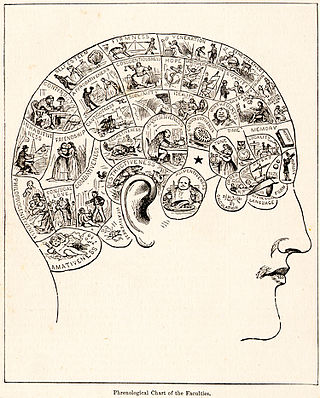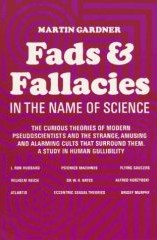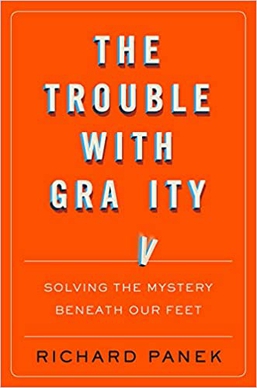
The meaning of life pertains to the inherent significance or philosophical meaning of living. There is not a definitive answer, and thinking or discourse on the topic is sought in the English language through the question, "What is the meaning of life?". There have been many proposed answers to these questions from many different cultural and ideological backgrounds. The search for life's meaning has produced much philosophical, scientific, theological, and metaphysical speculation throughout history. Different people and cultures believe different things for the answer to this question. Opinions vary on the usefulness of using time and resources in the pursuit of an answer. Excessive pondering can be indicative of, or lead to, an existential crisis.

Pseudoscience consists of statements, beliefs, or practices that claim to be both scientific and factual but are incompatible with the scientific method. Pseudoscience is often characterized by contradictory, exaggerated or unfalsifiable claims; reliance on confirmation bias rather than rigorous attempts at refutation; lack of openness to evaluation by other experts; absence of systematic practices when developing hypotheses; and continued adherence long after the pseudoscientific hypotheses have been experimentally discredited. It is not the same as junk science.

Alfred Rupert Sheldrake is an English author and parapsychology researcher. He proposed the concept of morphic resonance, a conjecture that lacks mainstream acceptance and has been widely criticized as pseudoscience. He has worked as a biochemist at Cambridge University, a Harvard scholar, a researcher at the Royal Society, and a plant physiologist for ICRISAT in India.

Michael Brant Shermer is an American science writer, historian of science, executive director of The Skeptics Society, and founding publisher of Skeptic magazine, a publication focused on investigating pseudoscientific and supernatural claims. The author of over a dozen books, Shermer is known for engaging in debates on pseudoscience and religion in which he emphasizes scientific skepticism.

Ufology is the investigation of unidentified flying objects (UFOs) by people who believe that they may be of extraordinary origins. While there are instances of government, private, and fringe science investigations of UFOs, ufology is generally regarded by skeptics and science educators as an example of pseudoscience.

Lawrence Maxwell Krauss is a Canadian-American theoretical physicist and cosmologist who taught at Arizona State University (ASU), Yale University, and Case Western Reserve University. He founded ASU's Origins Project in 2008 to investigate fundamental questions about the universe and served as the project's director.

Fads and Fallacies in the Name of Science (1957)—originally published in 1952 as In the Name of Science: An Entertaining Survey of the High Priests and Cultists of Science, Past and Present—was Martin Gardner's second book. A survey of what it described as pseudosciences and cult beliefs, it became a founding document in the nascent scientific skepticism movement. Michael Shermer said of it: "Modern skepticism has developed into a science-based movement, beginning with Martin Gardner's 1952 classic".

Sean Michael Carroll is an American theoretical physicist and philosopher who specializes in quantum mechanics, cosmology, and philosophy of science. Formerly a research professor at the Walter Burke Institute for Theoretical Physics at the California Institute of Technology (Caltech) department of physics, he is currently an external professor at the Santa Fe Institute, and the Homewood Professor of Natural Philosophy at Johns Hopkins University. He has been a contributor to the physics blog Cosmic Variance, and has published in scientific journals such as Nature as well as other publications, including The New York Times, Sky & Telescope and New Scientist. He is known for his atheism, his vocal critique of theism and defense of naturalism. He is considered a prolific public speaker and science populariser. In 2007, Carroll was named NSF Distinguished Lecturer by the National Science Foundation.

The Trouble with Physics: The Rise of String Theory, the Fall of a Science, and What Comes Next is a 2006 book by the theoretical physicist Lee Smolin about the problems with string theory. The book strongly criticizes string theory and its prominence in contemporary theoretical physics, on the grounds that string theory has yet to come up with a single prediction that can be verified using any technology that is likely to be feasible within our lifetimes. Smolin also focuses on the difficulties faced by research in quantum gravity, and by current efforts to come up with a theory explaining all four fundamental interactions. The book is broadly concerned with the role of controversy and diversity of approaches in scientific processes and ethics.
In quantum mechanics, superdeterminism is a loophole in Bell's theorem. By postulating that all systems being measured are correlated with the choices of which measurements to make on them, the assumptions of the theorem are no longer fulfilled. A hidden variables theory which is superdeterministic can thus fulfill Bell's notion of local causality and still violate the inequalities derived from Bell's theorem. This makes it possible to construct a local hidden-variable theory that reproduces the predictions of quantum mechanics, for which a few toy models have been proposed. In addition to being deterministic, superdeterministic models also postulate correlations between the state that is measured and the measurement setting.

God: The Failed Hypothesis is a 2007 non-fiction book by scientist Victor J. Stenger who argues that there is no evidence for the existence of a deity and that God's existence, while not impossible, is improbable.
The Foundational Questions Institute, styled FQxI, is an organization that provides grants to "catalyze, support, and disseminate research on questions at the foundations of physics and cosmology." It was founded in 2005 by cosmologists Max Tegmark and Anthony Aguirre,. It has run multiple worldwide grant competitions, the first of which provided US$2M to 30 projects. It also runs frequent essay contests open to the general public with $40,000 in prizes awarded by a jury panel and the best texts published in book format.

Why Darwin Matters: The Case Against Intelligent Design is a 2006 book by Michael Shermer, an author, publisher, and historian of science. Shermer examines the theory of evolution and the arguments presented against it. He demonstrates that the theory is very robust and is based on a convergence of evidence from a number of different branches of science. The attacks against it are, for the most part, very simplistic and easily demolished. He discusses how evolution and other branches of science can coexist with religious beliefs. He describes how he and Darwin both started out as creationists and how their thinking changed over time. He examines current attitudes towards evolution and science in general. He finds that in many cases the problem people have is not with the facts about evolution but with their ideas of what it implies.

Questions of Truth is a book by John Polkinghorne and Nicholas Beale which offers their responses to 51 questions about science and religion. The foreword is contributed by Antony Hewish.

Aeon is a digital magazine of ideas, philosophy and culture. Publishing new articles every weekday, Aeon describes itself as a publication which "asks the biggest questions and finds the freshest, most original answers, provided by world-leading authorities on science, philosophy and society." The magazine is published by Aeon Media Group, which has offices in London, New York, and Melbourne.
Ethan R. Siegel is an American theoretical astrophysicist and science writer, who studies the Big Bang theory. In the past he has been a professor at Lewis & Clark College and a blogger at Starts With a Bang, on ScienceBlogs and also on Forbes.com since 2016.

"Why is there anything at all?" or "why is there something rather than nothing?" is a question about the reason for basic existence which has been raised or commented on by a range of philosophers and physicists, including Gottfried Wilhelm Leibniz, Ludwig Wittgenstein, and Martin Heidegger, who called it "the fundamental question of metaphysics".

Sabine Karin Doris Hossenfelder is a German theoretical physicist, philosopher of science, author, science communicator, YouTuber, musician, and singer. She is the author of Lost in Math: How Beauty Leads Physics Astray, which explores the concept of elegance in fundamental physics and cosmology, and of Existential Physics: A Scientist’s Guide to Life’s Biggest Questions.

Brief Answers to the Big Questions is a popular science book written by physicist Stephen Hawking, and published by Hodder & Stoughton (hardcover) and Bantam Books (paperback) on 16 October 2018. The book examines some of the universe's greatest mysteries, and promotes the view that science is very important in helping to solve problems on planet Earth. The publisher describes the book as "a selection of [Hawking's] most profound, accessible, and timely reflections from his personal archive", and is based on, according to a book reviewer, "half a million or so words" from his essays, lectures and keynote speeches.

The Trouble with Gravity: Solving the Mystery Beneath Our Feet is a nonfiction popular science book by Richard Panek and published by Houghton Mifflin Harcourt on July 9, 2019.

















